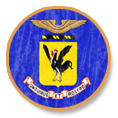Gossett remained on Yellow Channel and Number Two and Four tried to make contact on Dog Channel.” The three remaining members of How Flight “stayed in the area for approximately 20 minutes, orbiting the target, but were never able to contact the leader.” The 67th opened case no. 563 on F-51 serial No. 44-74655. The Check List noted that “pilot was on bomb run when he was hit by probable flak. The exact reason for the crash is not known. Number Two man stated he saw an explosion like a napalm [bomb] and decided it was an airplane crash. No chute was seen.”
The Air Force was never able to determine whether Capt. Ayer had been hit at low level or suddenly crashed; whether he had attempted to “limp” a disabled plane east to the nearest seacoast or south to friendly territory; or, whether he might have attempted to bail out. Cloud cover was spotty, but partially “decked” making it hard to see what was happening. Also local time was at 8 p.m., even in summer, a dimming twilight. Anti-aircraft fire was both persistent and good, as reported by a flight member. The flight also observed a ground explosion too large to be a rocket impact-they termed it a “secondary,” possibly an exploding target, but it could have been Capt. Ayer’s F-51.
A man’s man, a pilot’s pilot, Captain Elliot Dean Ayer was the last 18th Fighter-Bomber Wing F-51 Mustang pilot killed in action in the Korean War.

© Copyright 2015-2018 BelleAire Press, LLC
 Truckbusters
Truckbusters 